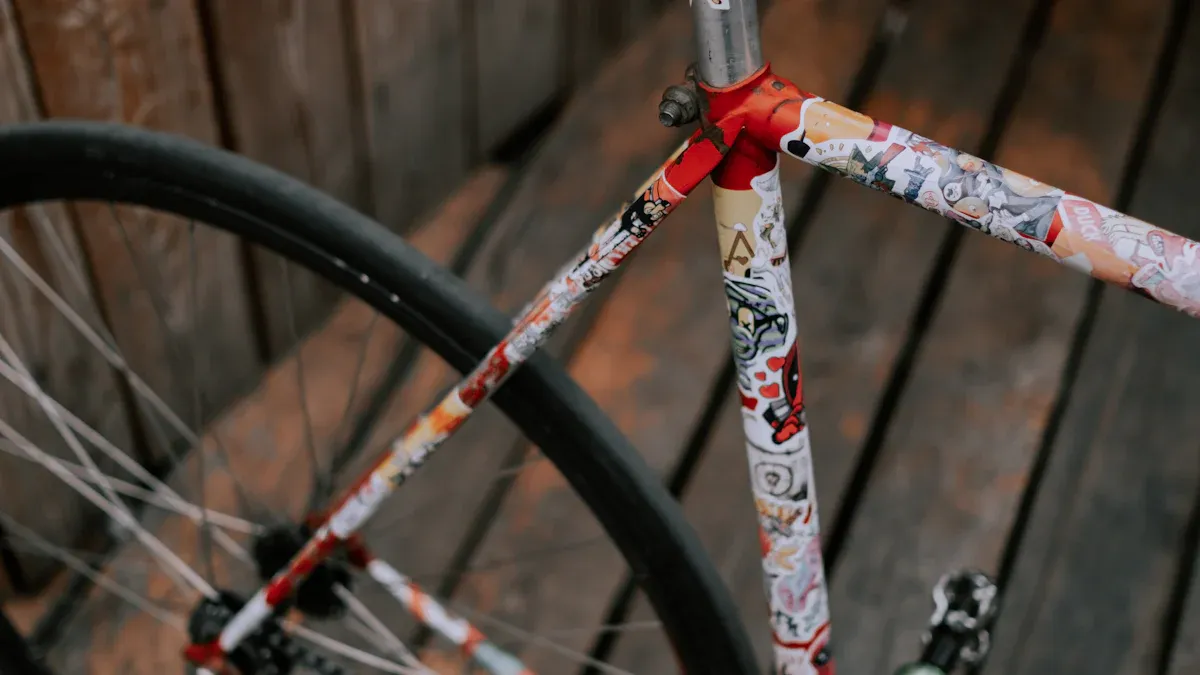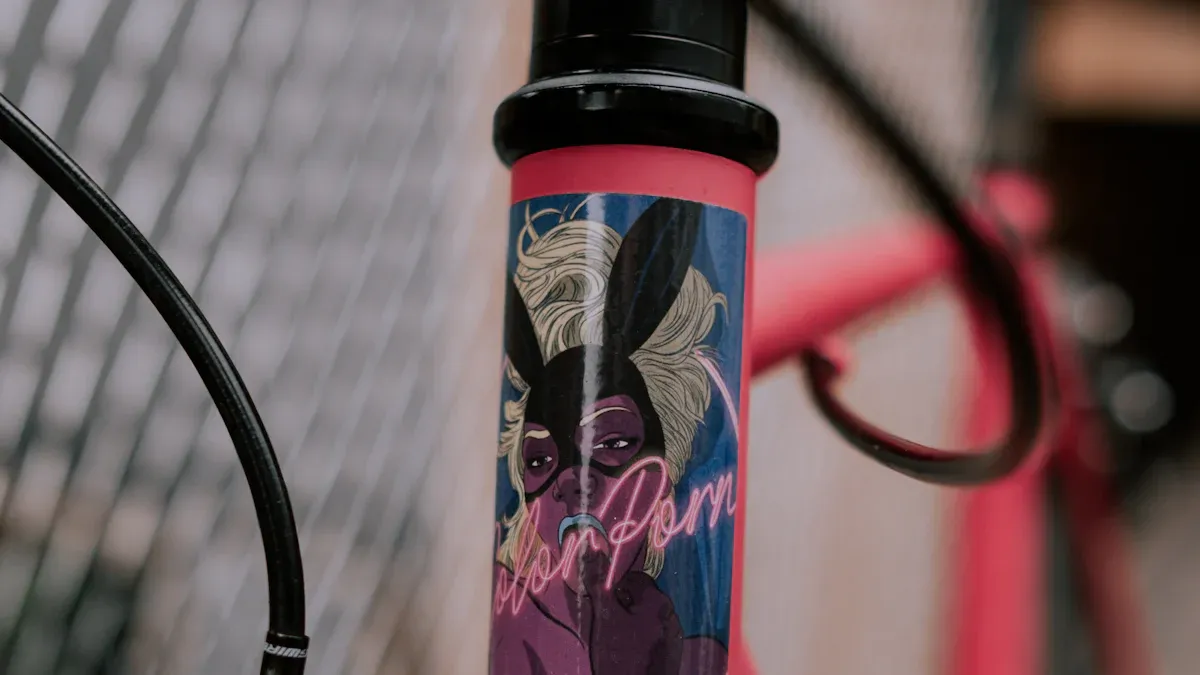
Choosing the right unpainted bike frame is very important for your cycling experience. It affects how well your bike performs and how it looks. A good frame can make your ride smoother and more fun. You should think about different things, like materials and weld quality, to make the best choice for you. After all, your bike is a part of you!
Key Takeaways
Pick the right material for your bike frame. Carbon fiber is light and strong. Aluminum is cheap and does not rust. Steel gives a smooth ride. Titanium is tough but costs a lot.
Check the welds and seams closely. Look for smooth seams and even bead sizes. Make sure there are no signs of overheating. This helps ensure a strong and safe frame.
Know about frame geometry. Different shapes change how the bike handles and feels. Think about reach, head tube angle, and stem length. This helps you find the best fit for your riding style.
Focus on a custom fit. A bike frame that fits well makes riding more comfortable. It also helps you perform better and lowers the chance of injury. Spend time finding a frame that meets your needs.
Enjoy the options for customization. Unpainted frames let you make your bike unique. You can choose your own colors and designs to make it truly yours.
Bike Frame Materials

When you pick an unpainted bike frame, the material is very important. It affects how your bike performs and feels. Each material has its own traits, advantages, and disadvantages. Let’s look at the most common bike frame materials: carbon fiber, aluminum, steel, and titanium.
Material Benefits
Carbon Fiber: This material is famous for being strong and light. It helps you ride faster without extra weight. Carbon fiber frames are also stiff, which means they transfer power well when you pedal. This makes them popular for high-end bikes.
Aluminum: Aluminum frames are light and resist rust. They balance performance and cost, making them popular with many riders. High-quality aluminum frames can handle a lot of stress, so you can trust their strength.
Steel: Steel frames are known for being strong and providing a good ride. They absorb bumps better than aluminum, giving you a smoother experience. If you want a frame that lasts, a good steel frame could be the right choice.
Titanium: This material offers the best of both worlds. Titanium frames are light and very strong. They resist rust and wear, making them last a long time. They can be pricier, but many cyclists love the unique ride they provide.
Here’s a quick look at the market share for these materials:
Material | Market Share | Description |
|---|---|---|
Aluminum | Lightweight, rust-resistant, and cheaper than premium materials. | |
Carbon Fiber | Fastest-growing | Strong and light, popular in high-end bikes. |
Material Drawbacks
Every material has its good and bad sides that you should think about:
Carbon Fiber: Even though it’s strong, carbon fiber can crack under too much stress. Damage might not always be easy to see, which can worry riders who push hard.
Aluminum: Aluminum frames are tough, but they can wear out quickly. If you’re heavy or ride on rough paths, you might see a drop in performance. Plus, aluminum can feel harsher than steel.
Steel: The main downside of steel is that it’s heavy. If you want a light bike, steel might not be the best choice. Also, steel frames can rust if not taken care of, especially in wet weather.
Titanium: The biggest problem with titanium is its price. It usually costs more than other materials, and fixing it can be hard because of how it’s made.
Here’s a summary of durability insights for each material:
Material | Durability Insights |
|---|---|
Aluminum | Can last a long time; high-end frames like Cannondale CAAD 3 passed durability tests. |
Steel | Usually has a shorter lifespan due to wear; failures often happen at joints. |
Carbon Fiber | Not very prone to wear; can last a lifetime unless damaged; strong and stiff. |
Titanium | May weaken at heat-affected areas; durability can change based on how it’s made. |
When you choose your unpainted bike frame, think about these factors carefully. Each material has its own benefits and possible problems, especially for customization and care. By knowing these details, you can make a better choice that fits your riding style and likes.
Evaluating Weld Quality

When you pick an unpainted bike frame, the weld quality is very important. Good welds make the frame stronger and help it perform better. Let’s look at the different types of welds and how to find good work.
Types of Welds
You will see several common weld types in unpainted bike frames. Each type has its own benefits and can change how long the frame lasts:
Lugged Construction: This method uses lugs to join the tubes. It makes it easy to replace broken tubes, which is helpful for repairs. Lugged frames are often a classic choice for custom bikes.
TIG Welding: This means Tungsten Inert Gas welding. It’s popular for high-end frames because it makes strong, clean joints. TIG welding is effective and gives great strength, making it a favorite among serious cyclists.
Fillet Brazing: This method creates nice-looking joints while keeping the frame strong. It’s often used in custom builds where looks are as important as performance.
Signs of Quality Welding
Now that you know the types of welds, how can you check their quality? Here are some signs to watch for:
Smooth Seams: Good welds should have smooth seams with no gaps or rough spots. If you see uneven surfaces or flaws, it might mean poor work. Smooth seams look better and help the frame stay strong.
Consistent Bead Size: A good weld will have the same bead size all around. If the bead changes a lot, it might mean the welder didn’t have steady control, which can weaken the frame.
No Overheating Signs: Check for discoloration near the welds. Overheating can make the metal weak, so you want to see clean, well-made welds without burn marks.
Visual Inspection: Look closely at the joints. If you find cracks or bubbles, avoid that frame. These problems can cause serious issues later.
By noticing these details, you can make sure the unpainted bike frame you choose has the quality needed for a safe and fun ride. Remember, a well-welded frame can really improve your cycling experience!
Tube Seam Quality
When you look at an unpainted bike frame, the quality of the seams plays a big role in its overall strength and durability. Different types of seams can affect how well your bike performs. Let’s dive into the types of seams you might encounter and how to inspect them.
Seam Types
Butted Seams: These seams are created by joining two tubes with varying wall thicknesses. The thicker ends provide strength, while the thinner parts reduce weight. This design helps create a lighter frame without sacrificing durability.
Continuous Seams: These seams run the entire length of the tube. They offer excellent strength and are often found in high-performance frames. However, they can add some weight compared to butted seams.
Mitered Seams: In this method, the ends of the tubes are cut at angles to fit together snugly. Mitered seams can create a clean look and strong joints, but they require precise cutting and fitting.
Inspection Tips
When inspecting seams, keep an eye out for these key indicators of quality:
Smoothness: Run your fingers along the seams. They should feel smooth and even. Rough or jagged edges can indicate poor workmanship.
Consistency: Look for uniformity in the seam width. If you notice variations, it might suggest a lack of control during the welding process.
No Gaps: Check for any gaps between the tubes. Gaps can weaken the frame and lead to failure over time.
Visual Cracks: Inspect the seams closely for any visible cracks or bubbles. These flaws can compromise the integrity of the frame.
By paying attention to these details, you can ensure that the unpainted bike frame you choose has the quality needed for a safe and enjoyable ride. Remember, a well-constructed frame can make all the difference in your cycling experience!
Ride Characteristics
When you pick an unpainted bike frame, knowing ride characteristics is very important. The shape of your frame affects how your bike rides and feels on the road.
Geometry and Handling
Frame geometry includes different measurements that change how your bike handles. Here are some key factors to think about:
Reach and Stack: These measurements affect your riding position and comfort.
Head Tube Angle: This angle changes how hard you steer and how stable your bike is. A steeper angle makes handling quicker, while a slacker angle gives more stability at high speeds.
Stem Length: Shorter stems make handling quicker, while longer stems slow it down.
Handlebar Width: Narrower bars help with aerodynamics but can feel twitchy. Wider bars make your bike more stable.
Trail: This combines head tube angle and fork rake. Less trail means faster handling, while more trail leads to slower handling.
Remember, “Change just one element and the handling changes.” This shows how sensitive bike handling is to changes in frame geometry.
The stability of your bike also relies on trail. A bike with a longer trail can be harder to keep on track around corners. Frame builders often mention bottom bracket height and wheelbase as important parts of handling.
Comfort vs. Performance
Finding the right mix of comfort and performance is key for a great ride. Here’s what you should know:
Aluminum frames are stiff, which helps performance, especially when loaded. But this stiffness can make the ride rough on bumpy roads compared to softer materials like steel.
Design choices, like wider tires and suspension parts, can improve comfort on aluminum frames.
Tire choice is important too. Wider, softer tires greatly boost ride comfort compared to just the frame material.
Many cyclists wrongly think that frame material is the main factor in ride comfort. In truth, the flex of the frame matters little for overall comfort. Instead, things like saddle choice and frame geometry are more important for long rides.
By understanding these points, you can choose an unpainted bike frame that fits your needs for both comfort and performance, leading to a better ride quality.
Custom Options for Unpainted Frames
When you think about unpainted bike frames, custom options can make your ride much better. Custom frame builders let you create a bike that fits your needs and style perfectly. Here’s what you need to know about these builders and why going custom is a good idea.
Custom Frame Builders
Custom frame builders focus on making unpainted frames just for you. They care about quality and fit, making sure every frame is made well. Here’s how they work:
Process | Description |
|---|---|
Geometry Design | Custom frame builders use years of experience to design bikes. They offer different sizes and meet specific rider needs, ensuring a perfect fit. |
Fabrication | Skilled artisans with over 50 years of experience handcraft the frames, ensuring high-quality work without cutting corners. |
Quality Control | They have strict quality control steps, like choosing great materials and making sure everything is aligned correctly. They promise not to sell any bad frames. |
Paint Quality | Frames come in unpainted, so you can choose your paint colors and designs, using strong and durable paint products. |
Assembly & Packaging | All frames are packed carefully to avoid damage during shipping, and they focus on helping customers if there are any problems. |
Choosing a custom frame means you get a bike that fits you perfectly. You can pick the shape, materials, and even the finish. This kind of personalization can really improve your riding experience.
Tailored Fit Considerations
Fit is very important when picking a bike frame. A well-fitted frame can help you ride better and avoid injuries. Here are some key points to think about:
Comfort: A good fit makes long rides more comfortable. If your bike feels nice, you’ll enjoy riding it more.
Performance: Research shows that a proper fit can help you ride more efficiently. When your bike fits well, you can pedal better, which means more speed and endurance.
Injury Prevention: A custom fit can lower the chance of injuries from cycling. Tailored fits have shown to help reduce the severity of these injuries.
By focusing on what you like and how you ride, you can build a bike that looks great and performs well. So, if you care about cycling, think about getting a custom unpainted frame that fits your needs.
Picking the right unpainted bike frame is very important for your cycling fun. Keep these key points in mind:
Material: Each material has good and bad sides. For example, light carbon frames are great on smooth roads. Aluminum or steel frames are better for mountain biking because they are strong.
Weld and Seam Quality: Checking welds and seams helps you get a strong frame that fits your riding style.
Geometry: Different bike types have special shapes for different uses. For example, road bikes are made for speed, while mountain bikes focus on stability.
Getting the right fit for your bike is very important. A frame that doesn’t fit well can cause discomfort and injuries over time. So, take your time to find the perfect unpainted bike frame that suits your style and needs. Enjoy your ride! 🚴♂️
FAQ
What is an unpainted bike frame?
An unpainted bike frame is one that does not have any paint on it. This lets you see the material and how well it is welded. It also gives you a chance to change the finish later.
Why choose an unpainted frame?
Choosing an unpainted frame lets you make your bike unique. You can pick the paint color and design that you like. Plus, it often shows off the skill and quality of the frame.
How do I know if a frame fits me?
To find the right fit, think about your height, inseam, and how you ride. Many companies have sizing charts. You can also try riding different frames to see which one feels good.
Can I customize an unpainted frame?
Yes! Unpainted frames are great for customization. You can choose the paint, stickers, and even parts to fit your style. Customizing makes your bike look better and perform well.
What maintenance does an unpainted frame require?
Unpainted frames need regular cleaning to stop rust and corrosion. Use a gentle cleaner and a soft cloth. If you live in a wet area, think about putting on a protective coating to keep the frame strong.
See Also
Selecting the Ideal Bike Frame Tailored to Your Requirements
Comprehensive Guide to Finding Your Perfect Surly Bike Frame
Finding the Best Step-Through Bike Frame for Your Lifestyle
